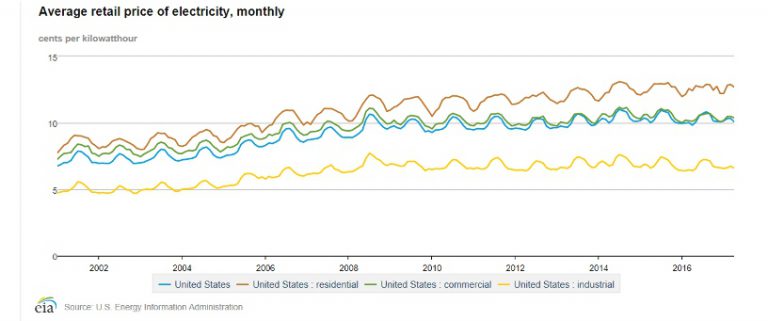Solar News & Information
Massachusetts High Energy Costs Favor Solar
July 2, 2017
Energy costs typically rise over time. While heating fuel prices may fluctuate season to season and within a season, the longer trend is that prices rise. Electricity costs also fluctuate, but the downward dips in prices are small and the increases are much more common.
Over the last decade retail costs have risen steadily across the country. In this graph from the U.S. Energy Information Administration (EIA), you can see a nominal fluctuation with months. However, over time the trend is a constant increase in the price of electricity, and it is especially true for residential energy costs. The industrial buyers benefit from preferred volume pricing and at times contracted commitments. But even with those advantages, that sector’s retail electricity prices have increased also.
In Massachusetts, you don’t have to search very long or dig very deep to find current efforts to request rate increases. For example, in June of 2017 Eversource is mulling a rate increase that will vary between locations as a 3% up to a 11% hike.
This may not be news for those ratepayers who watch the utilities closely. But everyone may be surprised to learn how Massachusetts compares both to our neighbors and to the other 50 states. There are a number of factors that make most analysts predict that power rates will continue to escalate, which is not a difficult conclusion to draw given history.
According to the EIA:
- Massachusetts has the most expensive residential retail electricity rates in New England, beating out Connecticut after a recent decrease in that state.
- Between April 2016 and April 2017 the overall retail price for the region dropped a small 0.21%. However, the Bay State rose by a small amount (about 0.55%).
- Nationwide, only the states of Hawaii and Alaska have more expensive electricity.
- The state is replacing over 3.4 gigawatts (GW) of generating capacity (coal, oil, and nuclear).
- As the study was completed, the state had added about 3 GW of new natural gas, solar, wind, and hydro capacity. Some may be imported from as far away as Canada, but more new capacity will likely be built, also.
- The state has a Renewable Portfolio Standard (RPS) and has voted recent policy changes to facilitate more solar energy, wind energy, and energy storage. ISO-NE expects that as much as 700 MW (0.7 GW) of solar PV could be installed by homeowners and landowners and others not a part of the utilities in the near future.
The first two pieces of data are frequently used by power companies as reasons when requesting rate increases. And the forecast non-utility capacity additions represent energy that will not produce revenue for any utility. The picture being painted here is one where most of the trends increase the utility costs to operate while potentially reducing their revenue sources by some amount. Even as natural gas prices currently are reportedly low, the cost to operate remains relatively high for the region.
There are few ways Massachusetts homeowners can change the trend of escalating costs. Certainly becoming more of an advocate and participating in the utility regulation process could be one way to have an impact. That takes time. Often that can take years.
Residents of the state and the elected people are more committed than ever to increasing the use of clean energy and solar energy, in particular. Solar prices have been declining over the past decade. Because of this, the opportunities for homeowners to get relief with a lowered, predictable energy budget have never been better.
Contact Us with questions or to see exactly how solar power will work for YOUR home, saving you thousands. It’s a free evaluation with absolutely no obligation.


